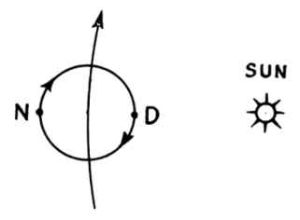The Sleepwalkers (225 page)
Authors: Arthur Koestler

This,
I
suggest,
explains
how
the
delusion
about
the
tides
could
gain
such
power
over
his
mind.
He
had
improvised
this
secret
weapon
in
a
moment
of
despair;
one
would
have
expected
that
once
he
reverted
to
a
normal
frame
of
mind,
he
would
have
realized
its
fallacy
and
shelved
it.
Instead,
it
became
an
idée
fixe
,
like
Kepler's
perfect
solids.
But
Kepler's
was
a
creative
obsession:
a
mystic
chimera
whose
pursuit
bore
a
rich
and
unexpected
harvest;
Galileo's
mania
was
of
the
sterile
kind.
The
tides,
as
I
shall
presently
try
to
show,
were
an
indirect
substitute
for
the
stellar
parallax
which
he
had
failed
to
find
–
a
substitute
not
only
in
the
psychological
sense,
for
there
exists
a
mathematical
connection
between
the
two,
which
seems
to
have
eluded
attention
so
far.
Galileo's
theory
of
the
tides
runs,
in
a
slightly
simplified
form,
as
follows.
2
Take
a
point
on
the
earth's
surface
–
say,
Venice.
It
has
a
two-fold
motion:
the
daily
rotation
round
the
earth's
axis,
and
its
annual
revolution
round
the
sun.
At
night
when
Venice
is
at
N,
the
two
motions
add
up;
in
daytime,
at
D,
they
work
against
each
other:

Hence
Venice,
and
with
it
all
the
firm
land,
moves
faster
at
night
and
slower
in
the
daytime;
as
a
result,
the
water
is
"left
behind"
at
night,
and
rushes
ahead
of
the
land
in
daytime.
This
causes
the
water
to
get
heaped
up
in
a
high
tide
every
twenty-four
hours,
always
around
noon.
The
fact
that
there
are
two
daily
high
tides
at
Venice
instead
of
one,
and
that
they
wander
round
the
clock,
Galileo
dismissed
as
due
to
several
secondary
causes,
such
as
the
shape
of
the
sea,
its
depth,
and
so
forth.
The
fallacy
of
the
argument
lies
in
this.
Motion
can
only
be
defined
relative
to
some
point
of
reference.
If
the
motion
is
referred
to
the
earth's
axis,
then
any
part
of
its
surface,
wet
or
dry,
moves
at
uniform
speed
day
and
night,
and
there
will
be
no
tides.
If
the
motion
is
referred
to
the
fixed
stars,
then
we
get
the
periodic
changes
on
the
diagram,
which
are
the
same
for
land
and
sea,
and
can
produce
no
difference
in
momentum
between
land
and
sea.
A
difference
in
momentum,
causing
the
sea
to
"swap
over"
could
only
arise,
if
the
earth
received
a
push
by
an
external
force
–
say,
collision
with
another
body.
But
both
the
earth's
rotation
and
its
annual
revolution
are
inertial,
3
that
is,
self-perpetuating,
and
hence
produce
the
same
momentum
in
water
and
land;
and
a
combination
of
the
two
motions
still
results
in
the
same
momentum.
The
fallacy
in
Galileo's
reasoning
is
that
he
refers
the
motion
of
the
water
to
the
earth's
axis,
but
the
motion
of
the
land
to
the
fixed
stars
.
In
other
words,
he
unconsciously
smuggles
in
the
absent
parallax
through
the
back
door.
No
effect
of
the
earth's
annual
motion
relative
to
the
fixed
stars
could
be
found.
Galileo
finds
it
in
the
tides,
by
bringing
the
fixed
stars
in
where
they
do
not
belong.
The
tides
became
an
Ersatz
for
parallax.
The
power
of
the
obsession
may
be
judged
by
the
fact
that,
although
a
pioneer
in
the
field
of
the
relativity
of
motion,
he
never
discovered
the
elementary
error
in
his
reasoning;
seventeen
years
after
he
had
hit
on
his
secret
weapon,
he
still
firmly
believed
that
it
was
the
conclusive
proof
of
the
motion
of
the
earth,
and
presented
it
as
such
in
his
Dialogue
on
the
Great
World
Systems
.
He
even
intended
to
name
that
work
Dialogue
on
the
Flux
and
Reflux
of
the
Tides
.